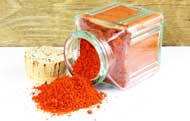





1. Chili Pepper Facts
2. Types of Chili Pepper
3. Chili Pepper Nutritional Value
4. Chili Pepper Health Benefits
The chili pepper is from the genus Capsicum, members of the nightshade family, Solanaceae. In western countries and some Asian countries it is simply known as "chilli". Chillies have been part of the human diet since at least 7500 BC. It is believed Diego Álvarez Chanca, a physician and companion of explorer Christopher Columbus, identified chillies as both a food and having medicinal uses in the 15th century. He wrote a book on their medicinal uses in 1494 and introduced the plant to Spain upon his return from Columbus’s second voyage.
History and Origin
Chillies originated in tropical regions of South America, but spread to Central American regions in pre-Columbian times. Christopher Columbus was the first European to encounter chillies and called them "peppers". Chillies were cultivated around the globe after Columbus.
Magical herbalism assigns chili peppers to Mars, the God of War. In central and southern America, chillies were used in magic and protection rituals. Sprinkled around the house it was believed they would ward off evil demons and vampires. Burned with garlic and other hot spices was a ritual used to fumigate and purify the house. This process is still believed to repel vermin and insects.
Chillies have long been regarded as an aphrodisiac with their fiery nature igniting the flame of passion. It is believed that chillies were used to control unruly children by subjecting them to the fumes. Research indicates that the Asians used chillies as a form of torture by rubbing it into wounds and sensitive mucous membranes and squirted it into the eyes of victims. Capsicum spray, which is tear gas containing capsaicin is commonly used by police world wide to control unruly citizens.
- • Bell pepper
- • Hungarian Pimento
- • Piquillo
- • Shishito
- • Hot Cherry
- • Jalapeño
- • Serrano
- • Habanero
- • Pimiento de Padrón
- • Aji Rojo
- • Thai
- • Hot Banana
- • Guernica
- • Cayenne
- • Anaheim
- • Basque Fryer
- • Bird’s Eye
- • Jamaican Hot
- • Carolina Reaper
- • Ghost Pepper
- • Chilaca
- • Guindilla Verde
- • Poblano
- • Tabasco pepper
Vegetables " Chili pepper " ( Nutritional value )
Nutritional value per 100 g
Peppers, hot chili, red, raw
|
Nutrient ( Proximate's )
|
Unit
|
Value
|
Daily Value %
|
|
Energy
|
kcal
|
40
|
2%
|
|
Protein
|
g
|
1.87
|
3.7%
|
|
Total lipid (fat)
|
g
|
0.44
|
0.005%
|
|
Carbohydrate, by difference
|
g
|
8.81
|
3.2%
|
|
Fiber, total dietary
|
g
|
1.5
|
5.3%
|
|
Sugars, total
|
g
|
5.3
|
|
|
Minerals
|
|||
|
Calcium, Ca
|
mg
|
14
|
1%
|
|
Iron, Fe
|
mg
|
1.03
|
5.7%
|
|
Magnesium, Mg
|
mg
|
23
|
5.4%
|
|
Phosphorus, P
|
mg
|
43
|
3.4%
|
|
Potassium, K
|
mg
|
322
|
6.8%
|
|
Sodium, Na
|
mg
|
9
|
0.3%
|
|
Zinc, Zn
|
mg
|
0.26
|
2.3%
|
|
Copper, Cu
|
mg
|
0.129
|
14.3%
|
|
Manganese, Mn
|
mg
|
0.187
|
8.1%
|
|
Selenium, Se
|
mcg
|
0.5
|
0.9%
|
|
Vitamins
|
|||
|
Vitamin C, total ascorbic acid
|
mg
|
144
|
160%
|
|
Thiamin (B-1)
|
mg
|
0.072
|
6%
|
|
Riboflavin (B-2)
|
mg
|
0.086
|
6.6%
|
|
Niacin (B-3)
|
mg
|
1.24
|
7.7%
|
|
Pantothenic acid (B-5)
|
mg
|
0.201
|
4%
|
|
Vitamin B-6
|
mg
|
0.506
|
29.7%
|
|
Folate, total (B-9)
|
mcg
|
23
|
5.7%
|
|
Vitamin B-12
|
mcg
|
0.00
|
|
|
Vitamin A, RAE
|
mcg
|
48
|
19%
|
|
Vitamin E (alpha-tocopherol)
|
mg
|
0.69
|
4.6%
|
|
Vitamin D (D2 + D3)
|
mcg
|
0
|
|
|
Vitamin K (phylloquinone)
|
mcg
|
14.0
|
11.6%
|
|
Lipids
|
|||
|
Saturated Fatty Acids
|
g
|
0.042
|
|
|
Monounsaturated Fatty Acids
|
g
|
0.024
|
|
|
Polyunsaturated Fatty Acids
|
g
|
0.239
|
|
|
Trans Fatty Acids
|
g
|
0.000
|
|
|
Carotenoids
|
|||
|
Beta-Carotene
|
mcg
|
534
|
|
|
Alpha-Carotene
|
mcg
|
36
|
|
|
Beta-Cryptoxanthin
|
mcg
|
40
|
|
|
Lutein + zeaxanthin
|
mcg
|
709
|
|

|
Reference Values are based on a 2,000 Calorie Intake, for Adults and Children 4 or More Years of Age. Your daily values may be higher or lower depending on your calorie needs.
|
|
Percentages are roughly approximated using (RDA) Recommended Dietary Allowances for adults. Source: USDA United States Department of Agriculture
|
|
Reference Values for Nutrition - FDA U.S. Food and Drug Administration
|
Chili pepper Nutritional Value
Chilli contains up to seven times the vitamin C level of an orange and has a range of health benefits,
Chilli contains up to seven times the vitamin C level of an orange and has a range of health benefits, including fighting sinus congestion, aiding digestion, and helping to relieve migraines and muscle, joint and nerve pain. It is also a good source of vitamins A and E, beta-carotene, folic acid and potassium. Chilli is also considered a potential metabolism booster for weight loss.
Capsaicin, the main bioactive plant compound in chili peppers binds with pain receptors, which are nerve endings that sense pain, therefore being beneficial in aiding pain relief. It also makes these pain receptors insensitive to other forms of pain, such as heartburn caused by acid reflux. Capsaicin blocks a natural chemical called Substance P, which is involved in the transmission and perception of pain. As a result, chillies can be useful in relieving and preventing common problems such as headaches, migraines and discomfort caused by sinus problems, allowing a person to relax more easily. Chillies are great at quickly and effectively opening nasal passages, allowing you to breathe more easily.
Studies indicate that capsaicin also lowers blood sugar levels. Eating chillies can have an incredibly positive impact on people that are overweight or suffer from diabetes. Regular consumption of chillies promotes weight loss by reducing appetite and increasing fat burning when combined with other healthy lifestyle strategies.
Chillies are regarded as being a circulation booster and acts as a thinner to help protect against strokes. Improving overall heart health. Eating chillies has been shown to lower cholesterol, reduce the amount of fibrin in the blood, and as a result, lower the blood's tendency to clot. Cultures where hot pepper is used liberally have a much lower rate of heart attack, stroke, and pulmonary embolism.
Capsaicin can irritate or burn your eyes or hands. Chili oil can stick to the skin, so wash hands thoroughly after handling peppers and be cautious about touching your eyes with your hands.
- BOOST IMMUNITY
Vitamin C and vitamin A content - PROTECTS AGAINST MACULAR DEGENERATION
(Beta-carotene) - CLEARS CONGESTION
Peppery heat stimulates the secretions that help clear mucus - STOMACH ULCERS
Killing bacteria while stimulating the cells lining the stomach

- CIRCULATION BOOSTER
Acts as a thinner protecting against strokes - OSTEOARTHRITIS PAIN
Topical capsaicin to alleviate the pain - TYPE 2 DIABETES
Vitamin C and carotenoids which help improve insulin regulation - HEART HEALTH
Reduces blood cholesterol, triglyceride levels to lower rate of heart attack
References
|
Nutrient Database - USDA (United States Department of Agriculture)
|
|
Reference Values for Nutrition - FDA U.S. Food and Drug Administration
|
|
Types of chillies (names only) - Chowhound (San Francisco food site)
|
|
Types of chillies (some names only) - Chili Pepper Madness web site (special tribute to all things chili peppers)
|
